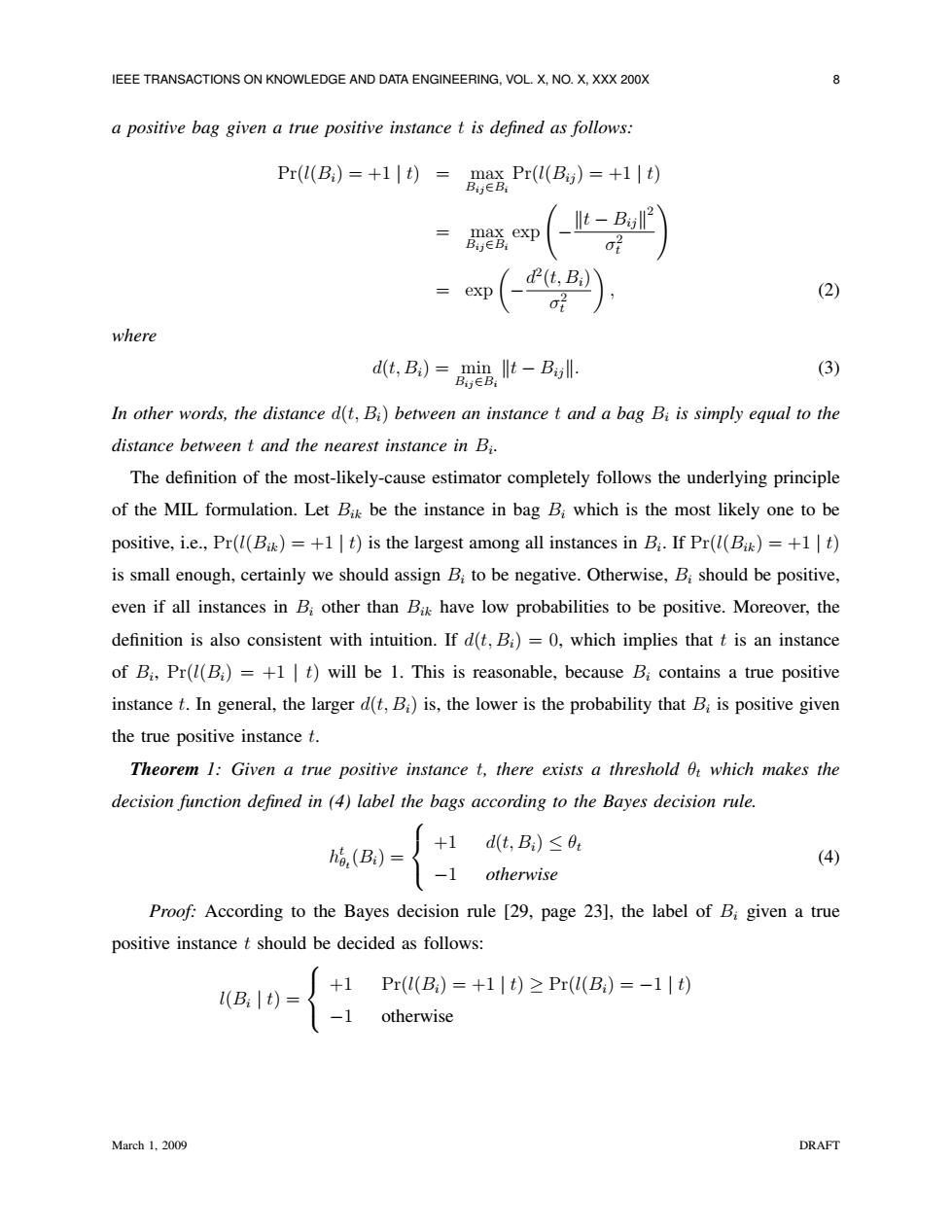正在加载图片...

IEEE TRANSACTIONS ON KNOWLEDGE AND DATA ENGINEERING,VOL.X,NO.X,XXX 200X 8 a positive bag given a true positive instance t is defined as follows: Pr(l(Bi)=+1t)=max Pr(l(Bii)=+1t) B∈B t- B 器ep d2(t,Bi) exp (2) where d(t,B)=min lt-Bl: (3) Bii∈B In other words,the distance d(t,Bi)between an instance t and a bag Bi is simply equal to the distance between t and the nearest instance in Bi. The definition of the most-likely-cause estimator completely follows the underlying principle of the MIL formulation.Let Bik be the instance in bag Bi which is the most likely one to be positive,i.e.,Pr(l(Bk)=+1t)is the largest among all instances in B:.If Pr(l(B)=+1t) is small enough,certainly we should assign Bi to be negative.Otherwise,B;should be positive, even if all instances in B:other than Bik have low probabilities to be positive.Moreover,the definition is also consistent with intuition.If d(t,Bi)=0,which implies that t is an instance of Bi,Pr(l(B)=+1t)will be 1.This is reasonable,because B;contains a true positive instance t.In general,the larger d(t,Bi)is,the lower is the probability that Bi is positive given the true positive instance t. Theorem 1:Given a true positive instance t,there exists a threshold O which makes the decision function defined in (4)label the bags according to the Bayes decision rule. +1 ,(B) d(t,B)≤0e (4) -1 otherwise Proof:According to the Bayes decision rule [29,page 23],the label of Bi given a true positive instance t should be decided as follows: (B:)= +1 Pr(l(Bi)=+1|t)z Pr(l(Bi)=-1|t) -1 otherwise March 1,2009 DRAFTIEEE TRANSACTIONS ON KNOWLEDGE AND DATA ENGINEERING, VOL. X, NO. X, XXX 200X 8 a positive bag given a true positive instance t is defined as follows: Pr(l(Bi) = +1 | t) = max Bij∈Bi Pr(l(Bij ) = +1 | t) = max Bij∈Bi exp − kt − Bijk 2 σ 2 t ! = exp − d 2 (t, Bi) σ 2 t , (2) where d(t, Bi) = min Bij∈Bi kt − Bijk. (3) In other words, the distance d(t, Bi) between an instance t and a bag Bi is simply equal to the distance between t and the nearest instance in Bi . The definition of the most-likely-cause estimator completely follows the underlying principle of the MIL formulation. Let Bik be the instance in bag Bi which is the most likely one to be positive, i.e., Pr(l(Bik) = +1 | t) is the largest among all instances in Bi . If Pr(l(Bik) = +1 | t) is small enough, certainly we should assign Bi to be negative. Otherwise, Bi should be positive, even if all instances in Bi other than Bik have low probabilities to be positive. Moreover, the definition is also consistent with intuition. If d(t, Bi) = 0, which implies that t is an instance of Bi , Pr(l(Bi) = +1 | t) will be 1. This is reasonable, because Bi contains a true positive instance t. In general, the larger d(t, Bi) is, the lower is the probability that Bi is positive given the true positive instance t. Theorem 1: Given a true positive instance t, there exists a threshold θt which makes the decision function defined in (4) label the bags according to the Bayes decision rule. h t θt (Bi) = +1 d(t, Bi) ≤ θt −1 otherwise (4) Proof: According to the Bayes decision rule [29, page 23], the label of Bi given a true positive instance t should be decided as follows: l(Bi | t) = +1 Pr(l(Bi) = +1 | t) ≥ Pr(l(Bi) = −1 | t) −1 otherwise March 1, 2009 DRAFT